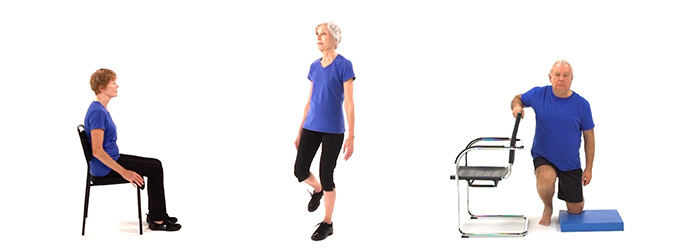Top 3 #GeriatricPT Exercises

Today, “Sally” walks in the front door of your clinic. She is the typical geriatric physical therapy client. Sally is in her late 70’s, recently widowed, and has noticed that she is not as active as before. Tasks like working in the garden and climbing stairs seem impossible. Sally heard an ad on the radio about how physical therapy can help older adults. Now she’s here to see you. After talking with Sally about her goals, you learn that she would like to be able to garden, play with her grandchildren, and walk without being afraid of falling down.
As a physical therapist who works almost exclusively with older adults, I see patients like Sally almost every day. Here are my top 3 exercises that I would prescribe to Sally – and almost every older adult client – to help her make her life more enjoyable.
1. Sit to Stand
Difficulty rising from a chair is a significant predictor for both falls and functional deficits in older adults.1 And let’s face it, most of our clients spend too much time sitting. We preach to our clients all the time on the importance of movement. Well, what if they can’t even get up from a chair? How are they supposed to exercise if they can’t exit the Lay-Z-Boy? Enter the “sit to stand” exercise. Even if your patient already is a sit to stand rockstar, you can still get creative with this basic exercise to challenge your most high-level clients.
Start by having your client sit in a basic armchair. Ask them to fold their arms across their chest and rise from the chair. If they can do it, great! Have them do it 5 more times. Ask them to gauge the degree of difficulty from 0 (easy) to 10 (impossible). If they rate it a 6-8…BOOM! There’s your exercise prescription.
Exercise Modifications
- If it’s too easy, consider adding reps, lowering the seat height, closing the eyes, holding weight, adding resistance bands, or performing on a single leg to sufficiently challenge your patient. If they need more resistance, you might consider additional loading via weighted squats or leg press. For more on the Clinical Search for the Optimal Load, see Scot Morrison’s post.
- If they cannot get up without using their hands, coach them to use the LEAST amount of assistance to successfully perform the task. Then increase the difficulty in future sessions. Don’t forget to vary the context to help them meet THEIR goal.
2. Floor Transfer
Too often I hear a story like Sally’s where a patient has had to stop playing with their grandkids or working in the garden because it has become too difficult to get up from the ground. However, progressive resistance exercise has been shown to improve physical function in older adults.2 So, with a little practice and some coaching from an awesome PT like yourself, they can get that ability back!
During your assessment, ask your client to kneel on the ground. I usually have a sturdy treatment table or chair nearby for assistance. Ask your client to place their “stronger” foot forward and slowly lower their opposite knee to the ground. Then ask them to rise from the ground into a standing position using their forward leg as the “power” leg. Initially, they may require your assistance or have to use one or two hands to help them get up.
Exercise Modifications
Work with your client where they are now and use your creative PT brain to make the activity challenging and meaningful. See the tips from Sit to Stand.
3. Single Leg Balance
I know what you’re thinking, “C’mon, single leg balance? Can’t you get a little more creative than that?” But let’s face it, older adults are at a higher risk for falling and that risk increases as their balance deteriorates, especially balance confidence.3 A simple and effective exercise to address balance and balance confidence is the single limb stance activity.
We’ve all seen and prescribed this exercise countless times, so I don’t need to tell you how it’s done. However, I will offer a few tips that have helped in my clinical practice. Consider moving your client away from the parallel bar to an area with plenty of space. Guard your patient as appropriate and allow them the opportunity to make errors and then refine their performance.
Exercise Modifications
As noted above, vary the environment, surface, lighting, or ambient noise to provide a sufficient challenge for your client and to make it meaningful for their goals. Consider adding head turns, head turns with gaze stabilization, eyes closed, or external perturbations to maximize the degree of difficulty. Adding in a dual task, such as holding a cup of water or performing a cognitive task can also enhance the degree of difficulty. Finally, you can add in an upper or lower extremity reach to further challenge your client.
So there you have it. Three simple, yet powerful exercises that will turn your “Sally” into the envy of the senior center.
- Zhang F, Ferrucci L, Culham E, Metter EJ, Guralnik J, Deshpande N. Performance on five times sit-to-stand task as a predictor of subsequent falls and disability in older persons. J Aging Health. 2013 Apr;25(3):478-92. doi: 10.1177/0898264313475813. Epub 2013 Feb 13. PubMed PMID: 23407343.
- Liu CJ, Latham NK. Progressive resistance strength training for improving physical function in older adults. Cochrane Database Syst Rev. 2009 Jul 8;(3):CD002759. doi: 10.1002/14651858.CD002759.pub2. Review. PubMed PMID: 19588334; PubMed Central PMCID: PMC4324332.
- Landers MR, Oscar S, Sasaoka J, Vaughn K. Balance Confidence and Fear of Falling Avoidance Behavior Are Most Predictive of Falling in Older Adults: Prospective Analysis. Phys Ther. 2015 Aug 20. [Epub ahead of print] PubMed PMID: 26294679









